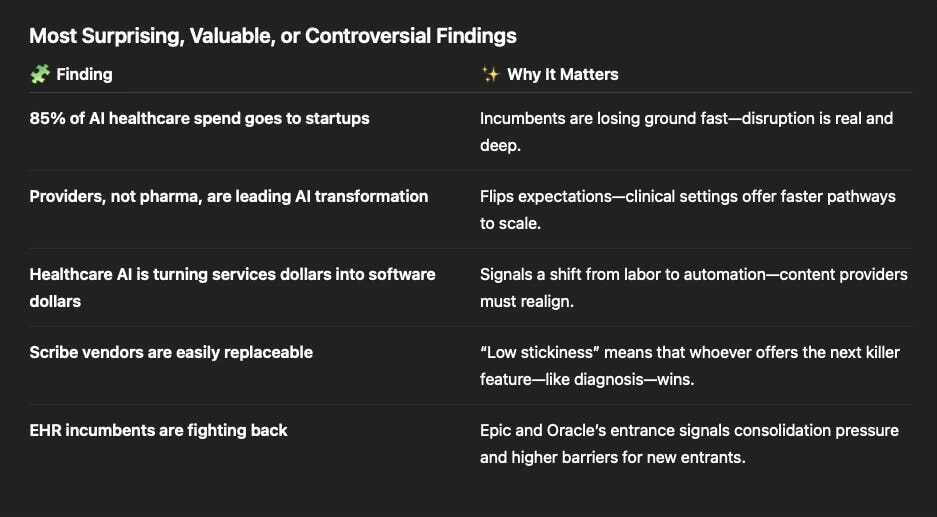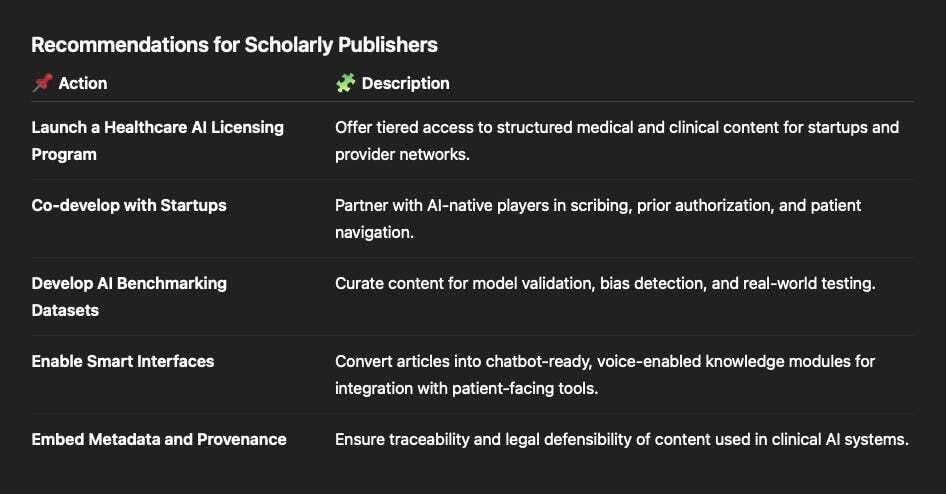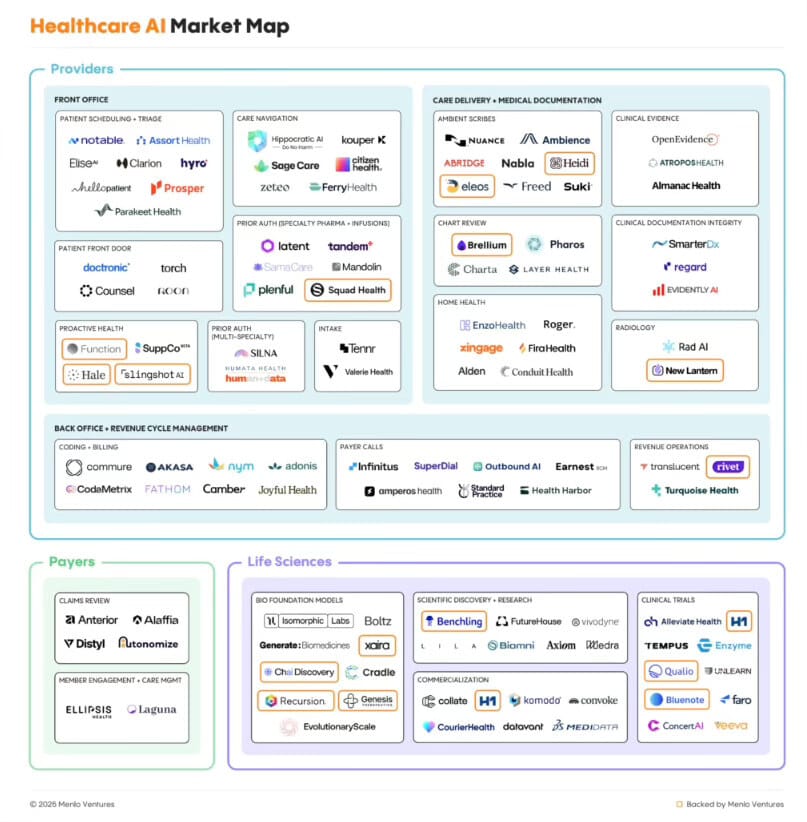- Pascal's Chatbot Q&As
- Posts
- 22% of healthcare organizations are now using AI, up from just 3% in 2023. Scholarly publishers—especially those active in medical, life sciences, and health research—should see this as a clarion call
22% of healthcare organizations are now using AI, up from just 3% in 2023. Scholarly publishers—especially those active in medical, life sciences, and health research—should see this as a clarion call
...to act. Healthcare is not only a fertile ground for AI innovation but also a massive content-rich domain where publishers’ assets, workflows, and expertise could be productively redeployed.
AI in Healthcare 2025: Opportunities and Innovation Pathways for Scholarly Publishers
Based on “2025: The State of AI in Healthcare” by Menlo Ventures
by ChatGPT-4o
Introduction: A Paradigm Shift Publishers Cannot Ignore
In what might be one of the most significant cross-sector transformations of the decade, the U.S. healthcare industry has emerged as the leading domain for enterprise AI adoption. Long seen as a digital laggard, healthcare has now leapfrogged other sectors by deploying domain-specific AI at over twice the rate of the broader economy. According to Menlo Ventures’ landmark 2025 report, 22% of healthcare organizations are now using AI, up from just 3% in 2023. Scholarly publishers—especially those active in medical, life sciences, and health research—should see this as a clarion call to act. Healthcare is not only a fertile ground for AI innovation but also a massive content-rich domain where publishers’ assets, workflows, and expertise could be productively redeployed.
Why Healthcare Is Now Leading the AI Race
Several systemic pressures have made healthcare ripe for AI:
High administrative burden: Post-pandemic clinician burnout, rising costs, and inefficiencies have made automation imperative.
Unprecedented investment: AI spending in healthcare reached $1.4 billion in 2025, nearly tripling from 2024, outpacing all other verticals except generic chatbots and coding assistants.
Startups dominate: 85% of that $1.4B went to startups, not incumbents—creating significant whitespace for new partnerships and knowledge-based AI tools.
Insight for publishers: This is an AI gold rush driven by data-rich, high-stakes problems. Academic publishers that can position themselves as curators of medical knowledge and trusted infrastructure partners for AI validation, training, or clinical decision-making have an edge.
Key Themes Relevant for Publishers
1. Ambient Documentation: The Breakout Use Case
Ambient scribes—AI tools that auto-generate clinical notes from doctor-patient conversations—grew to a $600M market in 2025. Startups like Abridge (30% market share) and Ambience (13%) outpaced incumbents like Microsoft Nuance’s DAX Copilot.
However, ambient scribing is hitting adoption plateaus (35%-40%) and vendor stickiness is low. Organizations are already seeking AI vendors that go beyond transcription—toward compliance, diagnosis, and billing.
Implication for publishers: This creates a unique opportunity to:
License structured content and clinical taxonomies to AI vendors expanding into clinical decision support.
Integrate publisher data with real-world usage (e.g., ambient scribe data) to inform better coding, diagnostics, and risk stratification tools.
2. From IT Budgets to Services Dollars: A $740B Opportunity
Traditionally, healthcare IT spend was just $63B, dwarfed by $740B in administrative overhead. AI is now unlocking these non-IT budgets by automating manual tasks in:
Revenue cycle management
Prior authorization
Patient engagement
Companies like Tandem, Latent, and Silna are automating processes that previously depended on nurses and admin staff.
Insight for publishers: These are content and knowledge automation problems. Publishers could:
Productize their clinical guidelines, research summaries, and compliance standards into AI-powered decision agents.
Develop voice-enabled or multilingual knowledge interfaces for patient engagement and health literacy tools, especially in underserved regions.
3. Payers and Pharma: Hesitant But Strategic
While providers lead AI deployment, payers (insurance companies) and biopharma firms are more cautious. Their AI investments remain small—just $50M from payers and less from pharma—but growing.
Pharma companies are especially focused on:
Proprietary model development using internal data
AI in R&D, regulatory compliance, and clinical trial optimization
Relevance for publishers:
There is growing demand for high-quality training data—structured literature, trial data, protocols, and real-world evidence—to fine-tune proprietary models.
Pharma companies may seek licensing deals for semantic access to journals and data to fuel their AI development.
4. AI Procurement Is Speeding Up—Except in Pharma
Provider buying cycles dropped to 6.6 months for health systems (from 8.0) and 4.7 months for outpatient providers (from 6.0). In contrast, payer timelines increased to over 11 months.
Takeaway: The fastest-moving customers are hospital systems—not pharma. For publishers, this suggests:
Prioritize partnerships with provider systems seeking knowledge solutions now.
Develop new licensing models for embedding publisher content in clinical workflow tools, not just in traditional search and browse interfaces.
5. Startups Winning with Speed and AI-Native Design
Startups dominate because they:
Have no legacy infrastructure slowing them down.
Design AI-first products rather than bolting features onto old software.
In contrast, incumbents like Epic and Oracle are just now integrating ambient scribing and AI agents into their platforms.
What this means for publishers:
Collaborate early with AI-native startups to co-develop solutions using curated medical or research content.
Build APIs or licensing portals to streamline access to structured, trustworthy content for AI model integration.
Strategic Lessons and Implications for Scholarly Publishers
🧠 1. Turn Research Content into AI-Ready Knowledge Assets
Transform static PDFs into structured, interoperable, and modular formats (e.g., FHIR-compatible, RDF, or JSON-LD) so they can power AI diagnostics, triage systems, and regulatory tools.
🤝 2. Develop Strategic Licensing Frameworks for Healthcare AI
Just like entertainment firms license IP to game or video producers, publishers should offer targeted licensing for healthcare AI companies—especially in clinical reasoning, diagnostics, coding, and care coordination.
🚨 3. Support AI Transparency and Regulatory Readiness
AI vendors in healthcare are under pressure to demonstrate clinical validation and compliance. Publishers can:
Offer trusted content provenance and citation support.
Collaborate on auditable model outputs and post-hoc explainability layers.
🌐 4. Explore New Markets: Language, Literacy, and Global Care
AI agents are beginning to power multilingual triage, self-care apps, and frontline navigation for underserved communities. Publishers should:
Localize high-impact medical knowledge.
Partner with NGOs, governments, and AI vendors in health equity projects.
📊 5. Position as Partners in AI Evaluation and Ethics
Given the risks of model hallucination, bias, and misdiagnosis, publishers could serve as evaluation hubs—curating benchmark datasets, synthetic testing cases, and compliance guardrails.

Final Thoughts: A Healthcare Inflection Point—and a Publisher’s Opportunity
The Menlo Ventures report shows that healthcare is not only undergoing a technological shift—it’s experiencing a full-scale operational reinvention powered by AI. Scholarly publishers, particularly those already serving medical, life sciences, or clinical research communities, have an unprecedented opportunity to redefine their role. No longer just passive distributors of knowledge, they can become active enablers of AI-powered care delivery.
Whether it’s:
Licensing content for AI triage tools
Powering regulatory compliance systems
Creating decision support modules
Validating clinical algorithms
Or training multilingual health AI agents
…the door is wide open for publishers who act boldly, structure their assets strategically, and partner early.

Bottom Line:
Healthcare is rapidly becoming the most consequential AI domain of the decade. Publishers who understand this shift and build bridges between academic knowledge and intelligent systems will help redefine the delivery, regulation, and accessibility of care—and future-proof their business in the process.
Let the AI-powered healthcare revolution begin—and let publishers help shape it.
